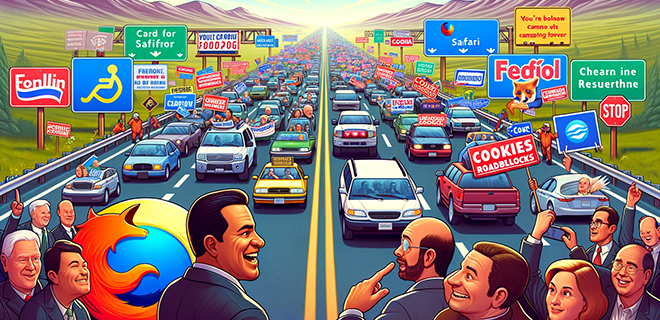
Cookieless advertising opens access to millions of untapped voters across Safari and Firefox. This election season, candidates embracing it could gain the edge needed to win key swing states. Eric Wheeler, CEO of 33Across, unpacks how cookieless environments offer higher ad performance, faster loads, and clearer paths to victory.
As we hit the home stretch in the Presidential election and other federal and statewide races, digital advertising spend continues to flourish.
But, candidates and their marketing teams may be fumbling on a key component of their playbook that could be the difference between first and second place: advertising to cookieless voters.
Google’s about-face (or flip flop) on deprecating cookies could lead advertisers — including political ones — to abandon their cookieless plans, but that would be shortsided as I explain below.
While the bulk of media attention is on the presidential election, there are also 468 Congressional races and a multitude of local elections. I would go as far as to say that a few politicians could sway their races by embracing cookieless, especially if their opponent neglects over half of the open web using Safari or Firefox browsers for example. There is an ocean of previously unreachable voters right in front of you, the billions of US consumers viewing content on cookieless browsers via mobile and desktop web.
It’s incredibly important to reach consumers where they consume content across mobile, desktop, or CTV. With emerging digital channels growing, those who do not advertise in cookieless environments may miss out on this campaign season’s biggest advantage.
Two Roads Ahead for the Candidates
Elections, at least in the United States, are often about choosing between two options. It’s either Republican or Democrat; left wing or right wing; yes or no on a proposition. Political candidates have some duality choices as well: whether to advertise only with third-party cookies, cookieless, or both. The good news is that candidates can — and should — advertise on both. But, like their for-profit corporate brethren, too few are embracing cookieless.
The polls make one thing abundantly clear: this will be a very close presidential election with multiple states currently within mere percentage points of each other. Even if the polls move in one direction or the other, there’s enough uncertainty that no one will know the winner until election night (and maybe thereafter).
The volume of ads seen in battleground states by the people who are legitimately swing votes are inundated with ads from both parties maligning their opponents and making conflicting claims. And while we historically think of TV ads as the bulk of political advertising, the money spent on digital continues to grow. Some estimates put it at 28% of all spent this cycle; 3x the figure from the last full election.
Valuable Audiences
Would Hillary Clinton have won the 2016 presidential election if she spent any time at all in Wisconsin? Flipping that state alone wouldn’t have procured enough electoral votes, but it was seen as emblematic of a campaign too confident in its superiority to a candidate to not do the simple work. She ended up losing the state by 23,000 votes as well as other important Midwest swing states like Michigan and Ohio. Today’s candidates need to assume nothing is certain and continue to reach every possible voter across the US.
Advertising allows candidates to reach both cookieless and cookied users across all browsers.
Yes, Chrome dominates the browser market share with 52% in the US, 15% of those users have opted into cookieless settings, Safari has 32% and Firefox has 4% of audiences. There are plenty of registered and likely voters who may not watch much TV and are therefore only going to see political messages if those candidates advertise in cookieless environments.
Increased Attention Share
There’s a reason why both candidates prefer not to campaign in the same state at the same time. You don’t want to share the spotlight. Any candidate who embraces cookieless in a race where the competition doesn’t have a clear space to reach out to key audiences while the competitor is in the noisy cookied environment. Cookieless has a much lighter ad load overall, so every impression you serve has more impact.
It’s always interesting when someone living in an uncontested state travels to a swing state and suddenly sees the political ads they were missing.
Well, right now Internet users in swing states who are using cookieless browsers are just like those travelers. Campaigns that embrace cookieless can reach undecided voters in key regions on previously considered unreachable browsers.
Higher Performance
An underrated component of cookieless advertising is that ad load is generally faster in cookieless environments. Imagine paying good money to get in front of an undecided voter, only to waste that opportunity because the ad didn’t load before the user moved on. Finding the right audience is only one part of the equation; delivering your message clearly and completely is just as important. Cookieless achieves that.
Bigger Gains
Politicians love winning. Since there are far fewer bidders on ads in cookieless environments, win rates can be as high as 10X higher than bidding on third-party cookies. We also see engagement rates as high, if not higher, as in third-party cookie environments. This is crucial in the final weeks of the campaign when politicians have to spend before election day. Being in an environment with higher win rates alleviates stress that ads won’t run and allows the campaigns to focus on other pressing matters.
The Home Stretch
As with all campaign decisions, the best advertising strategies are built upon common sense. If you were driving to the polls, would you take the traffic-filled road or the wide open lane to get you to the polls before everyone else? Political campaigns often need everything to go right to win. Embracing cookieless this 2024 season could be the difference between getting elected versus giving a consolation speech.